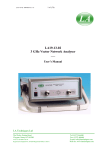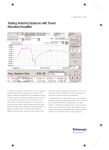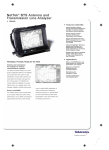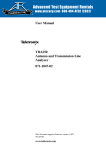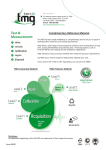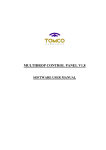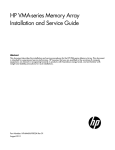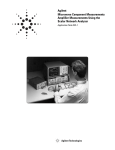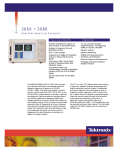Download File
Transcript
Application Note Basics of Using the NetTek YBA250 ® Properly Test Antennae and Locate Faults Use the NetTek YBA250 for determining the health of base station antenna systems, identifying transmission line trouble, and easily locating faults. The YBA250 performs swept reflection measurements over a frequency range from 25 MHz to 2500 MHz. This range covers the frequency bands for 2G and 3G cellular standards. It is also able to locate problems in antenna systems by measuring the Distance to Fault (DTF) of components in the system that cause large reflections. Antenna systems constitute an essential part of a cell. They could degrade their performance over time or have sudden failures, which may cause poor voice quality, loss of coverage and dropped calls. Testing antenna systems regularly increases the reliability of a cell site. This application note explains the basics of using the YBA250 to properly test antenna systems using calibrated reflection measurements in the form of Return Loss and VSWR. The YBA250 is used to diagnose the health of an antenna system including the antenna itself and the feed line components attached to it. An antenna is a device that radiates or absorbs radio waves in a certain frequency range. Ideally, an antenna would radiate all the power that is sent to it by the transmitter. In practice, however, some of that power is reflected back, as seen in Figure 1. The YBA250 generates RF signals and applies it to the antenna. The RF signal is generated in steps, point by point, from a start to a stop frequency. The core of the YBA250 is a test set that 1 www.tektronix.com/wireless Magnitude of the Reflection Coefficient ρ= Vreflected Vincident Return Loss RL = –20log10 (ρ) = –20log10 ( ) Vreflected Vincident Voltage Standing Wave Ratio VSWR = 1+ρ 1–ρ Incident signal Reflected signal Figure 1. Antenna reflection characteristics. separates the incident signal from the reflected signal for each frequency. The ratio of the reflected signal and the incident signal, known as reflection coefficient, is computed, corrected using calibration data, and displayed in the form of return loss or VSWR. Basics of Using the YBA250 Application Note Figure 2 shows an example of a return loss measurement of a GSM antenna that was connected directly to the test port of the YBA250. The frequency band of this antenna is from 1850 MHz to 1990 MHz. The Blue line in Figure 2 shows the measured return loss of the antenna. The Green line is a user-defined mask entered into the YBA250 that shows the manufacturer’s specifications. When the antenna meets the specification, the line is Green. The line turns Red when it does not. Return loss indicates how far down from the incident signal (at 0 dB), the reflected signal is. A larger value of return loss (farther down) indicates a smaller reflected signal, meaning a better antenna. In other words, more power is radiated and less power is reflected. All reflection measurement test sets introduce errors to the actual measurement results. They are removed by a process called calibration. In general, reflection measurements are usually made as a comparison of the device being measured to a known standard. This standard is assumed to be perfect. The process of comparing is called “calibrating” the measurement equipment. Calibration Calibration is a process that compensates for errors introduced by the reflection measurement test set. This process uses high-precision measurement standards whose characteristics are precisely known. The YBA250 calculates the difference between the measurement results from the calibration standards and the ideal results to create correction data. This data is used to remove deterministic errors from the measurement results. The YBA250 uses a calibration kit that contains three precision standards: an Open, a Short and a Load, such as the YBA250C1 (or equivalent). The accuracy of the measurements is determined by the quality of the standards, primarily Load. A measurement may indicate a return loss of 50 dB. This reading is meaningless, however, if the standard load used to make the calibration was specified to be only 40 dB. The calibration process in the YBA250 provides a unique feature. It is performed across its entire frequency range. Therefore, changing the frequency parameters of a measurement does not require re-calibration. The YBA250 offers two types of calibration: Factory Calibration and User Calibration. The Factory Calibration (Factory Cal) is done during manufacturing and the results are stored in non-volatile memory so that it can be used at any time. A User Calibration (User Cal) is 2 www.tektronix.com/wireless Figure 2. Return Loss of a GSM antenna (Blue line). performed before taking measurements and it also compensates for changes in temperature and component aging to ensure the most accurate measurement. A User Cal can be stored in the YBA250 and it can be recalled at another time. When using a non-precision cable to connect the YBA250 to the device under test, we recommend performing the calibration at the end of the cable to remove the effect of the jumper cable over the measurement results. The Factory Cal Can be Used When: The user does not need the best accuracy for his/her measurements A User Cal Should be Used When: The user wants to obtain the most accurate measurement possible The calibration is done at the end of a jumper cable (a cable between the YBA250 test port and the device under test) To Perform a Quality Calibration, We Recommend: Use of a high-precision calibration kit, such as the YBA250C1 Properly-tightened standard to ensure a good connection. A loose connection will produce poor calibration data Minimal cable movement when calibrating at the end of the cable More detailed information on calibration and accurate measurements can be found at [1] and [2] (see page 7). Basics of Using the YBA250 Application Note Performing a New Use Calibration Set output power (if necessary) Select where to perform calibration (Test port, end of cable) Antenna Testing Performed in the Field Antenna tests are usually performed at ground level, as shown in Figure 4. The measured return loss of the antenna will be affected by the connector(s), jumper cable(s) and transmission line (feed-line or feeder) that are in the path between the YBA250 calibrated output and the antenna port. Antenna Calibrate using OPEN, SHORT, and LOAD in any order Jumper cable OK Cancel Automatically saved as the current cal data set Transmission line (feeder) OK Save Possible test points Select name (to test points) Test Port YBA250 Connectors Duplexer BTS House Jumper cable Note: This graphic shows only one sector for simplicity. Figure 4. Antenna testing in the field. Figure 3. User calibration flowchart. Figure 3 shows a flowchart for the calibration process. A more detailed flowchart can be found in the YBA250 User Manual [3] (see page 7). The YBA250 makes measurements in two domains: frequency domain and distance domain. Tests using return loss (or VSWR) versus frequency are performed to determine the health of the antenna system. In the event that the antenna system fails these tests, distance domain diagnosis, known as Distance to Fault (DTF), is then performed in order to locate the fault. The conversion from frequency to distance is achieved by processing the reflection coefficient data using digital signal processing algorithms. www.tektronix.com/wireless 3 Basics of Using the YBA250 Application Note Using a Jumper Cable Another practical issue for antenna testing in the field is that the test points are usually in places that may make it difficult to directly connect the YBA250 test port to them (see Figure 4). Thus, a jumper cable is normally used between the test port of the YBA250 and the test points. The jumper cable’s reflection characteristics and loss cause errors in the reflection measurement. Both of these errors can be eliminated by calibrating the instrument at the end of the jumper cable. If a standard calibration kit is not available, the YBA250 can still make calibrated measurements using its Factory Calibration (Factory Cal). Since this calibration is performed at the test port, measurement test setups requiring the use of a jumper cable will be affected by the characteristics of the jumper cable. When performing measurements using the Factory Cal, it is recommended to use a precision jumper cable, such as the Tektronix part number 012-1619-00. The errors introduced by this cable are mainly due to its loss and not its reflection characteristics. These errors can be removed from the return loss results by subtracting two times the value of the cable loss from the return loss results (equivalent to raising the return loss waveform by twice the value of its cable loss). Figure 5 shows the return loss results of a GSM antenna system when using a precision cable of 1.4 dB loss. The Blue line is the measured return loss using Factory Cal. The Yellow line is the measured return loss using User Cal at the end of the precision jumper cable. Notice that the effects of the precision jumper cable are primarily to increase the actual return loss by about 2.8 dB. In other words, it makes the overall return loss measurement looks better (farther down) by about 2.8 dB. To obtain more accurate results, we recommend calibrating the YBA250 at the end of the jumper cable. 4 www.tektronix.com/wireless Figure 5. Return Loss of a GSM antenna (Blue: Factory Cal; Yellow: User Cal at end of cable). Other Devices in the Signal Path In some systems, a duplexer or filter may be found in the signal path between the test port of the YBA250 and the antenna’s port. A duplexer is a device that isolates the receiver and the transmitter paths allowing the use of a common antenna, reducing the numbers of antennae and feed lines in the system. A filter is a device used to pass frequencies within its frequency band with very little loss while attenuating all signals outside its band. Both components pass signals over a limited range of frequency and reflect those outside that range. Measuring return loss or VSWR with them in the signal path will indicate the quality of the entire system attached to the base station. Filters and duplexers present in the signal path will, to some degree, mask the antenna’s performance. For more accurate results about the antenna system, only those components pertinent to the antenna system should be in the signal path. Basics of Using the YBA250 Application Note Making Measurements in the Frequency Domain Making Measurements in the Distance Domain (DTF) Return Loss or VSWR in the frequency domain is the primary measurement tool to diagnose the health of an antenna system. The distance domain is return loss, or VSWR, measured as a function of distance along the coaxial cable connected to the YBA250. This secondary measurement tool is best known as Distance to Fault (DTF). It is used to locate faults when the measurements in the frequency domain indicate a problem; in other words, when the frequency-domain return loss results are out of spec. When performing DTF measurements, the YBA250 still sweeps the system under test in frequency, and the calibrated reflection coefficients are computed. Then, these results are transformed to the distance domain using digital signal processing algorithms. Calibration Set. Choose the most appropriate calibration data set (see Calibration) Frequency Setup. There are two ways to select how wide to sweep. Select the uplink/downlink button of the cellular standard used or dial the Start and Stop frequencies Saving Results. We recommend saving the results to monitor a possible degradation in the antenna system over time Figure 6 shows a flow diagram of the main steps when doing a frequency domain measurement. The YBA250 User Manual [3] (see page 7) has a detailed description of this process. Set output power (if necessary) The distance information is contained in how much the phase of the reflected signal changes with variations in frequency. The length of the coaxial cable(s) and the group delays of the devices in the signal path affect the change in phase. Each distance point in the DTF measurement is affected by all frequencies in the sweep. Therefore, one must be careful when setting the DTF in order to obtain meaningful results. The basic relationships between frequency and distance are given by: Set Calibration (Use Cal or Fact Cal) Dmax = Vp * C 1 BW ∆f = Set start and stop frequencies [a] * 2 = ∆f Fstop – Fstart ∆d = Dmax = N–1 Options Run Measurement [b] N–1 N–1 Vp * C 2 1 * [c] BW Set mask Save results Others Figure 6. Making frequency domain measurements. where, Dmax is the maximum measurable distance Vp is the velocity of propagation of the coax cable with respect to the speed of light C is the speed of light N is the number of frequency points in the sweep BW is the frequency bandwidth ∆f is the frequency step of the sweep ∆d is the distance resolution www.tektronix.com/wireless 5 Basics of Using the YBA250 Application Note Notice that D max is mainly determined by the ∆ f as indicated by Equation [a]. When a measurement with wide frequency span is possible, more frequency points can be acquired. This gives a better resolution in distance as indicated by Equation [c]. The YBA250 can acquire up to 4096 frequency points. This capability is used to offer several levels of distance resolution and maximum distance according to the method used to setup the DTF as explained below. Calibration Set. Choose the most appropriate calibration data set (see Calibration) Distance Setup. The YBA250 offers a unique configurable tool that makes it easier for the user to set up the DTF. On previous products, the DTF mode has been difficult to adjust to trade off the start and stop frequency and the number of measurement points to get the total range and distance resolution desired. The YBA250 is designed to allow the user to set the controls in terms of performance required. The user can select between two setup modes: by Cover Distance and by Limit Bandwidth Cover Distance is recommended when no frequency-limited devices, such as filters or duplexers, are in the signal path. In this mode, the user enters the desired total distance and the YBA250 automatically adjusts values to make sure that the actual measured distance covers the user’s desired distance. Thus, the actual covered distance may be greater than or equal to the user’s desired distance, but will not be less. In this mode, a change in the distance resolution relates to a change in the number of frequency points. The methods for this mode are Fast, Normal or High Resolution. Fast is used if a high update rate is desired but high resolution is not required. Normal gives a somewhat slower update rate but better distance resolution. The High-Resolution method gives the highest distance resolution, making it possible to identify which end of a jumper, at the top of a tower, needs repair. This method requires longer measurement time. 6 www.tektronix.com/wireless Limit Bandwidth is recommended when frequency-limited devices, such as filters or duplexers, are in the signal path and one would like to “see” beyond these devices. The user enters the frequency parameters by choosing the central frequency and bandwidth. The YBA250 then finds the distance-related parameters. The actual bandwidth used in the measurement will be less than or equal to the value entered by the user. This guarantees that the signal stays within the specified range. Notice that according to Equation [c], fixing the frequency bandwidth also fixes the distance resolution. When the bandwidth is fixed, a change in the number frequency points changes the maximum distance as indicated by Equation [b]. In this case, the methods are Fast, Normal and Long Distance. If a fault is located beyond these devices, the distance to the fault may be displayed as being farther away than it actually is. This occurs because these devices add delay to the RF signal traveling, forwards and backwards, through them. If the DTF setup contains frequencies outside the specifications of a frequency-limited device, the DTF results might be meaningful only at distances less than or equal to the distance where the device is and will never be good beyond it. In general, the results may be poor or completely useless. This occurs because the device will reflect the RF signal at frequencies outside its bandpass and the effects of measurement at each point in the sweep are combined at each distance point of the DTF measurement. In other words, reflections off the device’s input at some frequencies will affect the compound result at each distance point in the distance domain. A fault that does not exist may be shown at the device’s input and a fault beyond the device may not be “seen” by the instrument. DTF could be used to determine the return loss of an antenna by taking the amplitude of the DTF at the distance where the antenna is. This method, however, is not nearly as accurate as the return loss vs. frequency measurement described in Making Measurements in the Frequency Domain. If used, however, one should set up the DTF by Limit Bandwidth and be careful to make sure that the sweep is not wider than the antenna’s bandwidth. The return loss, or VSWR, shown at the distance where the antenna is will be roughly correct but will be affected by the transmission line loss vs. frequency selected in the DTF setup. Basics of Using the YBA250 Application Note The principal goal of the DTF measurement is to locate the fault; therefore, a smaller distance resolution is desired which requires measurements over a wide frequency range. Limiting the frequency range to the bandpass of the in line device will result in poor distance resolution. Figure 7 shows a flow diagram of the main steps when doing a DTF measurement. The YBA250 User Manual [3] contains a detailed description of this process. Set output power (if necessary) Set Calibration (Use Cal or Fact Cal) Is there any frequency-limited device in the signal path? (filter, duplexer) Yes Want to see beyond those devices? Yes Conclusion The YBA250 performs swept reflection measurements, in the form of return loss and VSWR, in frequency domain and distance domain. Return loss (VSWR) in the frequency domain is the primary tool to diagnose the health of an antenna system. If the diagnostics suggest there is a fault, DTF measurements are taken to determine where the fault is. Reflection measurements are usually calibrated to improve accuracy. The quality of the standards used during the calibration determines the accuracy of the measurements. Since the calibration process in the YBA250 is performed across its entire frequency range, changing the frequency parameters of a measurement does not require re-calibration. Other unique features of the YBA250 are the factory calibration set and the DTF setup. The former allows making calibrated measurement when the standards are not available. The latter allows the user to set up the DTF by distance or frequency and view their actual values before performing measurements. These unique features translate into time savings when testing antenna systems. Recommended Literature No Set DTF by Cover Distance Set DTF by Limit Bandwidth Options Run Measurement Save results Others Figure 7. Making DTF measurements. [1] Application Note: Accurate Antenna Measurements and the NetTek YBA250 Literature Number: 2GW-15651-0 URL: http://www.tek.com/Measurement/App_Notes/2G_15651/ eng/2GW_15651_0.pdf [2] Application Note: Accurate Reflection Measurements and the NetTek YBA250 Literature Number: 2GW-15653-0 URL: http://www.tek.com/Measurement/App_Notes/15653/ eng/2GW_15653_0.pdf [3] YBA250 User Manual Part Number: 071-1047-01 www.tektronix.com/wireless 7 Contact Tektronix: ASEAN / Australasia / Pakistan (65) 6356 3900 Austria +43 2236 8092 262 Belgium +32 (2) 715 89 70 Brazil & South America 55 (11) 3741-8360 Canada 1 (800) 661-5625 Central Europe & Greece +43 2236 8092 301 Denmark +45 44 850 700 Finland +358 (9) 4783 400 France & North Africa +33 (0) 1 69 86 80 34 Germany +49 (221) 94 77 400 Hong Kong (852) 2585-6688 India (91) 80-2275577 Italy +39 (02) 25086 1 Japan 81 (3) 3448-3010 Mexico, Central America & Caribbean 52 (55) 56666-333 The Netherlands +31 (0) 23 569 5555 Norway +47 22 07 07 00 People’s Republic of China 86 (10) 6235 1230 Poland +48 (0) 22 521 53 40 Republic of Korea 82 (2) 528-5299 Russia, CIS & The Baltics +358 (9) 4783 400 South Africa +27 11 254 8360 Spain +34 (91) 372 6055 Sweden +46 8 477 6503/4 Taiwan 886 (2) 2722-9622 United Kingdom & Eire +44 (0) 1344 392400 USA 1 (800) 426-2200 USA (Export Sales) 1 (503) 627-1916 For other areas contact Tektronix, Inc. at: 1 (503) 627-7111 Updated 20 September 2002 For Further Information Tektronix maintains a comprehensive, constantly expanding collection of application notes, technical briefs and other resources to help engineers working on the cutting edge of technology. Please visit www.tektronix.com Copyright © 2003, Tektronix, Inc. All rights reserved. Tektronix products are covered by U.S. and foreign patents, issued and pending. Information in this publication supersedes that in all previously published material. Specification and price change privileges reserved. TEKTRONIX and TEK are registered trademarks of Tektronix, Inc. All other trade names referenced are the service marks, trademarks or registered trademarks of their respective companies. 05/03 HB/SFI 2EW-16667-0 8 www.tektronix.com/wireless








